Related Research Articles
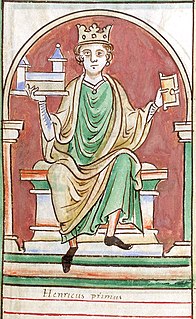
Henry I, also known as Henry Beauclerc, was King of England from 1100 to his death in 1135. He was the fourth son of William the Conqueror and was educated in Latin and the liberal arts. On William's death in 1087, Henry's elder brothers Robert Curthose and William Rufus inherited Normandy and England, respectively, but Henry was left landless. He purchased the County of Cotentin in western Normandy from Robert, but his brothers deposed him in 1091. He gradually rebuilt his power base in the Cotentin and allied himself with William Rufus against Robert.

William I, usually known as William the Conqueror and sometimes William the Bastard, was the first Norman king of England, reigning from 1066 until his death in 1087. A descendant of Rollo, he was Duke of Normandy from 1035 onward. By 1060, following a long struggle to establish his throne, his hold on Normandy was secure. In 1066, following the death of Edward the Confessor, William invaded England, leading an army of Normans to victory over the Anglo-Saxon forces of Harold Godwinson at the Battle of Hastings, and suppressed subsequent English revolts in what has become known as the Norman Conquest. The rest of his life was marked by struggles to consolidate his hold over England and his continental lands, and by difficulties with his eldest son, Robert Curthose.
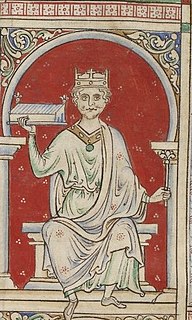
William II was King of England from 26 September 1087 until his death in 1100, with powers over Normandy and influence in Scotland. He was less successful in extending control into Wales. The third son of William the Conqueror, he is commonly referred to as William Rufus, perhaps because of his ruddy appearance or, more likely, due to having red hair as a child that grew out in later life.
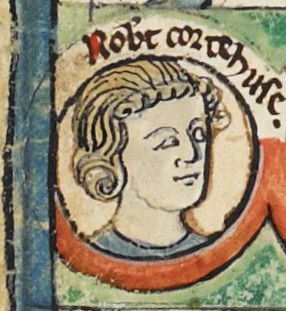
Robert Curthose, or Robert II of Normandy, was the eldest son of William the Conqueror and succeeded his father as Duke of Normandy in 1087, reigning until 1106. Robert was also an unsuccessful claimant to the throne of the Kingdom of England. The epithet "Curthose" had its origins in the Norman French word courtheuse 'short stockings' and was apparently derived from a nickname given to Robert by his father; the chroniclers William of Malmesbury and Orderic Vitalis reported that William the Conqueror had derisively called Robert brevis-ocrea.

Robert Fitzhamon, or Robert FitzHamon, Seigneur de Creully in the Calvados region and Torigny in the Manche region of Normandy, was the first Norman feudal baron of Gloucester and the Norman conqueror of Glamorgan, southern Wales. He became Lord of Glamorgan in 1075.
Hugh de Grandmesnil, , is one of the proven companions of William the Conqueror known to have fought at the Battle of Hastings in 1066. Subsequently, he became a great landowner in England.
Robert de Bellême, seigneur de Bellême, seigneur de Montgomery, viscount of the Hiémois, 3rd Earl of Shrewsbury and Count of Ponthieu, was an Anglo-Norman nobleman, and one of the most prominent figures in the competition for the succession to England and Normandy between the sons of William the Conqueror. He was a member of the powerful House of Bellême.

The Rebellion of 1088 occurred after the death of William the Conqueror and concerned the division of lands in the Kingdom of England and the Duchy of Normandy between his two sons William Rufus and Robert Curthose. Hostilities lasted from 3 to 6 months starting around Easter of 1088.
Robert D'Oyly was a Norman nobleman who accompanied William the Conqueror on the Norman conquest, his invasion of England. He died in 1091.

de Lacy is the surname of an old Norman family which originated from Lassy, Calvados. The family took part in the Norman conquest of England and the later Norman invasion of Ireland. The name is first recorded for Hugh de Lacy (1020–1085). His sons, Walter and Ilbert, left Normandy and travelled to England with William the Conqueror. The awards of land by the Conqueror to the de Lacy sons led to two distinct branches of the family: the northern branch, centred on Blackburnshire and west Yorkshire was held by Ilbert's descendants; the southern branch of Marcher Lords, centred on Herefordshire and Shropshire, was held by Walter's descendants.
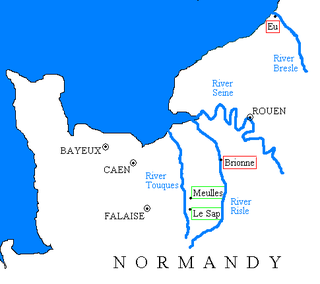
Baldwin FitzGilbert was a Norman magnate and one of the 52 Devon Domesday Book tenants-in-chief of King William the Conqueror, of whom he held the largest fiefdom in Devon, comprising 176 holdings or manors. He was feudal baron of Okehampton, seated at Okehampton Castle in Devon.
Richard de Courcy was a Norman nobleman and landholder in England.

The House of Tosny was an important noble family in 10th and 11th century Normandy, though it did not include any comtes or vicomtes. Its founder was Raoul I of Tosny.
Urse d'Abetot was a Norman who followed King William I to England, and became Sheriff of Worcestershire and a royal official under him and Kings William II and Henry I. He was a native of Normandy and moved to England shortly after the Norman Conquest of England in 1066, and was appointed sheriff in about 1069. Little is known of his family in Normandy, who were not prominent, but he probably got his name from the village Abetot. Although Urse's lord in Normandy was present at the Battle of Hastings, there is no evidence that Urse took part in the invasion of England in 1066.

William de Chesney was an Anglo-Norman magnate during the reign of King Stephen of England and King Henry II of England. Chesney was part of a large family; one of his brothers became Bishop of Lincoln and another Abbot of Evesham Abbey. Stephen may have named him Sheriff of Oxfordshire. Besides his administrative offices, Chesney controlled a number of royal castles, and served Stephen during some of the king's English military campaigns. Chesney's heir was his niece, Matilda, who married Henry fitzGerold.
Hamo Dapifer was an Anglo-Norman royal official under both King William I of England and his son King William II of England. He held the office, from which his epithet derives, known in Latin as dapifer and in French seneschal, in English "steward", as well as the office of Sheriff of Kent.
Roger d'Ivry or d'Ivri or Rog'ive or Roger Perceval was an 11th-century nobleman from Ivry-la-Bataille in Normandy. He was the younger son of Robert de Breval and his wife, Albreda, daughter of Rodolph, Lord of Ivry.
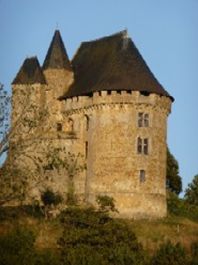
Wynebald de Ballon, (c.1058–c.1126), was an early Norman magnate. He appeared in England during the reign of William Rufus, along with his brother, Hamelin de Ballon, later created 1st Baron of Abergavenny.
The feudal barony of Gloucester or Honour of Gloucester was one of the largest of the mediaeval English feudal baronies in 1166, comprising 279 knight's fees, or manors. The constituent landholdings were spread over many counties. The location of the caput at Gloucester is not certain as Gloucester Castle appears to have been a royal castle, but it is known that the baronial court was held at Bristol in Gloucestershire.
Hugh de Beauchamp was a Norman who held lands in England after the Norman Conquest.
References
- Collins, Arthur (1812). The Peerage of England. London: F. C. and J. Rivington.